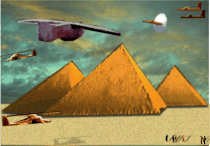"The Pilate Inscription....Page 33
GoodNews Magazine

When Pilate saw that he was getting nowhere, but that instead an uproar was starting, he took water and washed his hands in front of the crowd. "I am innocent of this man's blood," he said. "It is your responsibility!" ...Matthew 27:24
Click and drag photo to resize. 
Once Jesus was arrested, on Caiaphas’s
orders, He was tried before Caiaphas and
later sent to the Roman governor Pontius
Pilate. The New Testament portrayal of Pilate
agrees with other historical accounts.
“Philo
and Josephus unite in attributing dire and evil
practices to Pilate, so that a dark character is
ascribed to him” (The Interpreter’s Dictionary
of the Bible, 1989,Vol. 3, p. 813).
Philo, the Alexandrian Jewish philosopher
(20 B.C.–A.D. 50), described Pilate as “a
man of a very inflexible disposition, and very
merciless as well as very obstinate.” He says
Pilate’s rule was characterized by “corruption,
. . . insolence, . . . cruelty, . . . continual
murders of people untried and uncondemned,
and his never ending, and gratuitous,
and most grievous inhumanity” (The Works of Philo
translated by C.D. Yonge,
“On the Embassy to Gaius,” pp. 301-302).
Years after Christ’s crucifixion Pilate was
sent to Rome to undergo a humiliating trial
after ordering the massacre of some Samaritan
pilgrims. Eusebius, the fourth-century
historian, notes that Pilate was found guilty
and exiled. In his shame he later committed
suicide. Such was the end of this proud and
corrupt governor.
For centuries Pilate was known only from
scant historical records and the Gospels. No
direct physical evidence had been found.
Then, in 1961, a stone plaque engraved with
Pilate’s name and title was discovered in
Caesarea, the Roman port and capital of
Judea in Christ’s day.
“The two-foot by
three-foot slab, now known as the Pilate
Inscription,was . . . apparently written to
commemorate Pilate’s erection and dedication
of a Tiberium, a temple for the worship
of Tiberias Caesar, the Roman emperor
during Pilate’s term over Judea.
“The Latin inscription of four lines
gives his title as ‘Pontius Pilate, Prefect of
Judea,’a title very similar to that used of
him in the Gospels (see Luke 3:1).
This
was the first archaeological find to mention
Pilate, and again testified to the accuracy
of the Gospel writers. Their understanding
of such official terms indicates they lived
during the time of their use and not a century
or two thereafter, when such terms
would have been forgotten” (Randall Price,
The Stones Cry Out, 1997, pp. 307-308).
Gruesome evidence of crucifixion
Until recently some scholars considered
the description of Christ’s crucifixion to be
false. They thought it was impossible for a
human body to be held up by nails driven
into the hands and feet since the flesh would
eventually tear away.
Instead they thought
the victims must have been bound by ropes.
Yet, in 1968, the body of a crucified
man dating to the first century was found in
Jerusalem.
Here the true method of crucifixion
was discovered: His ankles, not his feet,
had been nailed and could easily support
his weight.
Archaeologist Randall Price explains:
“This rare find has proved to be one of the
most important archaeological witnesses to
Jesus’crucifixion as recorded in the Gospels.
First, it reveals afresh the horrors of the
Roman punishment . . .
This method of execution
forced the weight of the body to be
placed on the nails, causing terribly painful
muscle spasms and eventually death by the
excruciating process of asphyxiation . . .
Second, it was once claimed that the
Gospel’s description of the method of cruci-
fixion was historically inaccurate . . . The
discovery of the nail-pierced ankle bone
refutes those who say nails could not have
been used” (Price, pp. 309-310).
The Roman law of the time prescribed
crucifixion as punishment for the most
serious offenses, such as rebellion, treason
and robbery.
A famous example of mass crucifixions
took place in 71 B.C. when Spartacus
led a slave rebellion against Rome. He
ultimately failed, and the 6,000 captured
slaves were crucified.
The Jews knew of crucifixions even
before Roman rule, for around 87 B.C. the
Jewish king Alexander Janneus had 800
rebellious Pharisees crucified.
Josephus,
who witnessed the crucifixion of his fellow
Jews during the siege of Jerusalem (A.D.
66-70), called it “the most wretched of
deaths.”
It continued to be the punishment
for high crimes until the time of Emperor
Constantine, when it was finally abolished.
a tree’ . . .).” (1985, “Cross, Crucify”).
Source:The Bible and
Archaeology
Sections 13-24...
Good News Magazine


1, 2, 3, 4, 5, 6, 7, 8, 9, 10, 11, 12, 13, 14,
15, 16,
17, 18,
19, 20,
21, 22,
23, 24,
25, 26,
27, 28,
29, 30,
31, 32,
33, 34,
35
Next>>>


 Home
Home 20th Century Dinosaurs
20th Century Dinosaurs Dinosaurs in Literature, Art & History
Dinosaurs in Literature, Art & History Eyewitness Accounts
Eyewitness Accounts There Were Giants In The Earth in Those Days
There Were Giants In The Earth in Those Days Mega Fauna
Mega Fauna Those Sophisticated "Cave Men"
Those Sophisticated "Cave Men" Search for Noah's Ark
Search for Noah's Ark DNA, The Ultimate Oopart
DNA, The Ultimate Oopart The Bone Yards
The Bone Yards Underwater Cities, Monuments?
Underwater Cities, Monuments? Ancient Atomic Knowledge?
Ancient Atomic Knowledge? Salvation. What Must You Do To Be Saved?
Salvation. What Must You Do To Be Saved? Search
Search Links
Links Guestbook
Guestbook
